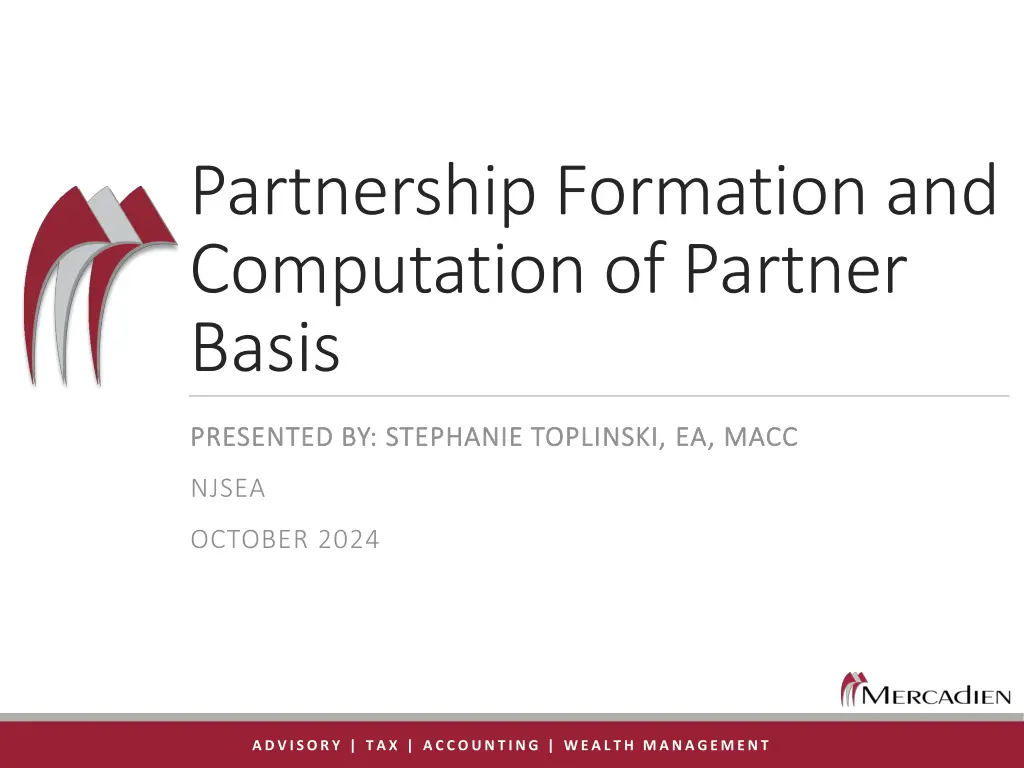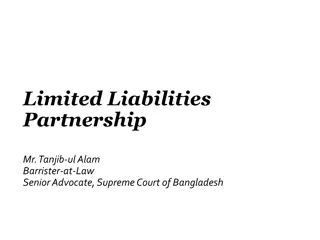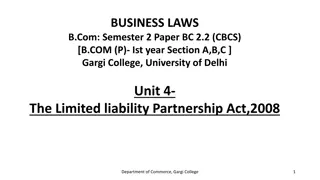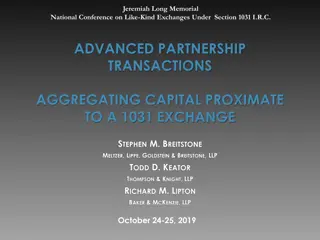
Understanding Partnership Basis and Elections
Learn about partnership formation and computation of partner basis, the tax implications of transferring property to a partnership, partner and partnership basis, events causing inequality in bases, sale of partnership interest, Code Sec. 754 election, and holding period rules for partners.
Download Presentation

Please find below an Image/Link to download the presentation.
The content on the website is provided AS IS for your information and personal use only. It may not be sold, licensed, or shared on other websites without obtaining consent from the author. If you encounter any issues during the download, it is possible that the publisher has removed the file from their server.
You are allowed to download the files provided on this website for personal or commercial use, subject to the condition that they are used lawfully. All files are the property of their respective owners.
The content on the website is provided AS IS for your information and personal use only. It may not be sold, licensed, or shared on other websites without obtaining consent from the author.
E N D
Presentation Transcript
Partnership Formation and Computation of Partner Basis PRESENTED BY: STEPHANIE TOPLINSKI, PRESENTED BY: STEPHANIE TOPLINSKI, EA EA, , MACC MACC NJSEA OCTOBER 2024 ADVISORY | TAX | ACCOUNTING | WEALTH MANAGEMENT
Partnership Interest When property is transferred to a partnership in exchange for a partnership interest, generally no gain or loss is recognized. This is generally a tax-free exchange. Contributions to an S corporation in exchange for stock are taxable unless shareholders owning (after the exchange) 80 percent or more of the outstanding stock make contributions to the S corporation in the same transaction.
Partners and Partnerships Basis The partner has an exchangedbasis in the partnership interest. Equal to the combined bases of the contributed properties. The partnership takes a transferredbasis in the contributed property. Equal to the contributing partner s basis.
Partnership Basis At formation, the total of the partnership s basis in its properties ( insidebasis ) equals the total of the partners bases in their partnership interest ( outside basis ). However, many events can cause inequality between the inside and outside bases.
Sale of Partnership Interest When a partnership interest is sold (absent a Code Sec. 754 election), the partnership s inside basis remains unchanged but the outside basis is changed. Often the difference between the inside and outside basis equals the seller s gain or loss on the sale. If a Code Sec. 754 election is made, equality between the inside and outside basis usually continues.
Code Sec. 754 Election This election allows the partnership to adjust the basis of its assets to reflect the gain or loss recognized by the contributor-partner on the sale of his or her partnership interest. This avoids recognizing a gain or loss twice (once when the partnership disposes ofthe contributed asset, and another when the partner sells his or her interest in the partnership).
Holding Period A partner must add the holding period of contributed capital and Code Sec. 1231 assets to the holding period of his or her partnership interest (which was received for contributing the assets). The partnership interest received for contributions of other property starts the day after it s received.
Depreciation Methods When depreciable property is contributed in a tax- free exchange, the partnership must use the transferor s depreciation method and remaining depreciable life. No basis increase is allowed if a partner recognizes gain on a contribution of encumbered property to the partnership.
Depreciation Methods (Cont.) If there s a Code Sec. 754 election in effect to the extent that a partner s net debt relief causes gain to be recognized on the contribution (and the property s basis in the partnership s hands is greater than its basis in the transferor s hands), the increase in basis is treated as a separate asset.
Code Sec. 705 Basis Adjustments The partner s partnership interest basis is increased by the partner s share of taxed income. So, when the partner sells his interest in the partnership, the previously taxed income isn t taxed again. The partner s partnership interest basis is also increased by his share of tax-exempt income. Nondeductible non-capitalized expenditures reduce the basis of partnership interest. Deductible losses or expenses reduce the basis of the partnership interest.
Effect of Partnership Operations on Basis Income and Loss Taxable and Tax-Exempt A basis increase is necessary when taxable income is earned, otherwise it could be taxed a second time as gain from the sale of the partnership interest when it s eventually sold. A basis increase is necessary when tax-exempt income is earned to avoid having the tax-exempt income result in increased gain (or reduced loss) on the sale of the partnership interest.
Effect of Partnership Operations on Basis (Cont.) A partner s basis must be reduced for his share of the partnership s losses. Otherwise, the partner would be allowed a second loss (or reduced gain) on sale of the partnership. If increased loss, or reduced gain was allowed on tax-exempt income, then the income would essentially no longer be tax-free.
Effect of Partnership Operations on Basis (Cont.) Contributions and Distributions Contributions result in an increased basis. Distributions result in a decreased basis. Distributions may not make the basis go below zero. The adjustments to basis are intended to ensure that: 1) A partner s share of taxable income and deductions is taken into account only once. 2) Nondeductible expenditures and tax-exempt income remain characterized as such. 3) Distributions of previous contributions and previously taxed income are not taxed.
Effect of Partnership Operations on Basis (Cont.) Each partner s tax basis capital account is now required to be disclosed on the partner s Schedule K-1. Although this balance does not account for the effect of liabilities on basis, it can be helpful in determining the partner s basis in the partnership.
Contributions of Encumbered Property Both the contributing partner and the other partners should treat the contribution of encumbered property as consisting of 2 steps: 1) The existence of the debt is ignored and the contributing partner increases his or her basis by the amount of the contributed property s basis. 2) The debt is taken into account. Each partner has a deemed cash contribution or distribution, depending on whether their share of debt went up or down. Partners with deemed cash contributions will increase their basis by that amount and partner s with deemed cash distributions will decrease their basis by that amount.
Contributions of Encumbered Property (Cont.) When encumbered property is contributed to a partnership and the partnership becomes primarily liable for paying the debt, the contributing partner s non-partnership-related liabilities for which he or she is directly responsible decrease by the amount of such debt. This is treated as a cash distribution from the partnership. However, in taking over this liability, the partnership s indebtedness increases by the same amount. This means that each partner is treated as having made a cash contribution to the partnership in the amount of his or her share in the new debt.
Contributions of Encumbered Property (Cont.) Exanple: The ABCD equal partnership was originally funded with contributions from A, B, C, and D. A made a contribution of property with a basis of $60,000, fair market value of $100,000, and subject to a liability of $20,000. The $20,000 liability is the only liability of the partnership, and during the first year the partnership pays off $12,000 of it. In the first year the partnership has $200,000 of business income, $20,000 of long-term capital gains, $5,000 of tax-exempt interest, and makes a charitable contribution of $16,000. In addition, the partnership makes a campaign contribution of $1,000 to a candidate for federal office. A s beginning basis will be $60,000 ($20,000 $5,000) net debt relief = $45,000. $94,000"
Contributions of Encumbered Property (Cont.) A s basis at the end of the first year will be: Beginning basis Share of: Ordinary business income Long-term capital gains Tax-exempt interest Charitable contribution Nondeductible campaign contribution Decrease in debt Ending basis $45,000 50,000 5,000 1,250 (4,000) (250) (3,000) $94,000 $94,000"
Contributions of Encumbered Property (Cont.) Example: A and B each have a tax basis in their partnership interest of $550. C contributes additional real estate (Parcel B) to the partnership, which has a tax basis and value of $850, and is made an equal one-third partner in capital, profits, and losses. The property is encumbered by a recourse liability of $300, responsibility for which the partnership assumes. To account for C s entry, the partnership will make the following accounting entry: Real property, Parcel B Mortgage, Parcel B Capital, Partner C $850 $300 $550 $94,000"
Contributions of Encumbered Property (Cont.) Partner C s tax basis in the partnership interest is determined as follows: Tax basis of contributed property (Parcel B) Debt transferred to partnership (deemed cash distribution) Partner C s share of debt (1/3rd) Partner C s tax basis in the partnership $850 (300) 100 $650 $94,000"
Contributing Property Creating a Gain To determine a partner s net debt relief: An increase in the partner s share of debt from the previous year-end to the current year-end is deemed a cash contribution. The cash contribution is offset against the partner s debt taken over by the partnership and any net debt relief is deemed a cash distribution. If this cash distribution exceeds his basis in the partnership interest, the excess is gain.
Partnership Capital Accounts Three different capital accounts: Tax Basis Book Basis Fair Market Value
Contributions Requiring Special Considerations Property Subject to Depreciation Recapture The depreciation recapture provisions generally require that when recapture property is transferred the potential recapture amount is taxed.
Contributions Requiring Special Considerations (Cont.) Partnership Recognizes Code Sec. 1245 Gain: When the partnership eventually sells the contributed property, it may be required to recapture depreciation deductions previously claimed either before or after the contribution. To the extent the gain on a subsequent sale represents the difference between the fair market value of the Code Sec. 1245 property and the adjusted tax basis at the time of contribution, that gain including the recapture will be allocated to the contributing partner.
Contributions Requiring Special Considerations (Cont.) Accounts Receivable Considered property and may be transferred free of taxation pursuant to Code Sec. 721. The contributor s basis in the accounts receivable will become the partnership s transferred basis in the receivables. The partnership will report income if its collections of these receivables exceed their transferred basis.
Contributions Requiring Special Considerations (Cont.) Suspended Losses Any losses suspended by Code Secs. 465 or 469 prior to the contribution of the related activity remain with the contributing partner and are not transferred to the partnership. If the activity produces income in the partnership s hands, it will be either passive income or income from a former passive activity which can be offset by any of the activity s unused passive activity deductions from a prior year. All income generated by the activity on the partnership s hands results in an additional at-risk amount.
S Corporation Comparison Formation Section 351 requirements: Property is transferred to the corporation, The transfer is solely in exchange for stock in the corporation, and Immediately after the exchange the participants to the exchange are in control of the corporation.
S Corporation Comparison (Cont.) Formation - Effect of S corporation operations on shareholder basis. Very similar to the effect of operations on partners bases. Not affected by the liabilities of the S corporation. Contribution of Encumbered Property. No treatment of the net debt relief to the shareholder as money distributed. The excess of the liabilities contributed with the properties over the bases of the assets contributed is recognized as gain by the contributing shareholder






















